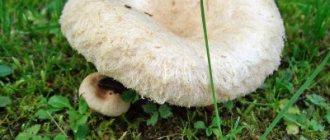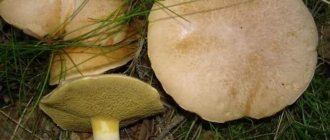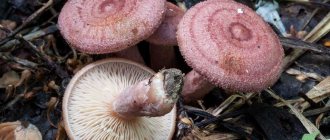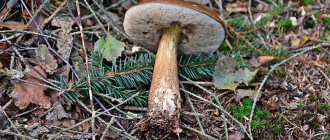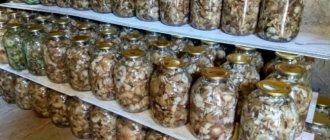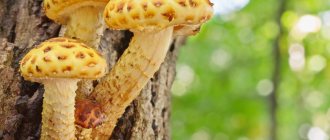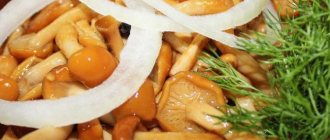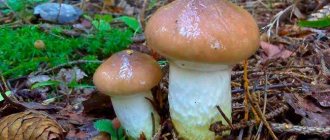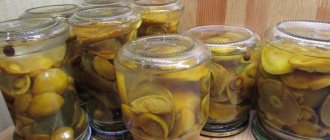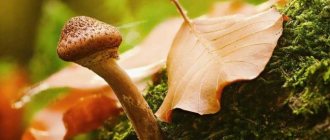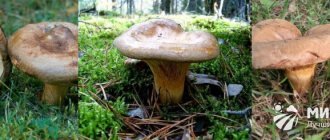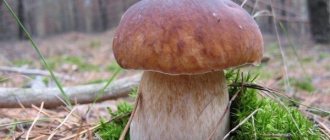Mushrooms
0
3450
Article rating
Kira Stoletova
Russula (bruise mushrooms) are the most popular mushrooms in the forests. They got their name from their ability to be eaten raw. However, they are edible and inedible.
Bruise mushrooms
What soil does this mushroom prefer?
It loves open forests, but the largest specimens grow where there is a lot of humus. After all, for bluelegs it doesn’t matter whether there are trees; the earth is more important to them. They love humus, sandy or semi-sandy soils. Bluelegs can often be found on abandoned farms, near piles of garbage or manure, on rotted leaves and fallen pine needles. They love to grow near fences and even in gardens and orchards. It is believed that rowers are most often found in open areas, especially in meadows and other grazing areas.
Where does the meadow lilac-footed row (two-color) grow?
Very tasty and popular among mushroom pickers is the meadow lilac-legged row. Its name speaks for itself, because it grows in pastures and meadows. In its taste and properties, this fruiting body is similar to champignons. In the marinade, the row takes on a snow-white appearance and amazing taste. However, experts believe that meadow row and lilac-legged are the same type of mushroom.
Where does the lilac-legged row grow and what places does it prefer to grow? Here everything will depend on soil and climatic conditions. Rows grow in all kinds of soils, and if the weather is favorable, then the harvest of these fruiting bodies will be large. In addition, the lilac-legged rower can be found in urban forest parks and in private plots. The mushroom is unpretentious, it would be warm and humid. It can often be seen in coniferous forests and forest plantations, where sandy soil predominates. They also prefer semi-sandy and humus soils. They even grow on fallen pine needles and rotted leaves.
The two-color row is widespread in the temperate zone of the Northern Hemisphere, in Kazakhstan, the Black Sea region and in the European part of the Russian Federation. But we must not forget that even edible types of grass, which are collected within the city or near industrial enterprises, are much more toxic than their meadow and forest counterparts. Very often, such mushrooms cause poisoning.
When to collect purple-footed row, so that it is not overgrown and retains all its beneficial vitamins and properties? I would like to say that these fruiting bodies, especially those growing in the southern regions of the country, can produce 2 harvests per year. The first appears in the spring and lasts until the beginning of autumn, and the second begins at the end of summer and continues until the first frost, that is, almost until the month of November. Under favorable weather conditions and with proper cutting of the row, mushroom pickers can collect these fruiting bodies in the same place for several years. Experienced mushroom pickers, knowing the places and timing of fruiting of the bicolor row, can collect from 100 to 150 kg of these mushrooms per season. Mushroom pickers love to collect it due to its dense pulp and resistance to transportation. Even after collecting the row in bags, you don’t have to worry: until you bring it home, it won’t break.
The proposed photos and descriptions of the blue-legged row will not allow inexperienced mushroom pickers to confuse this mushroom with another inedible species.
The fruiting bodies are resistant to cold, so they can be found even in late autumn and even in December. But other types of mushrooms do not have this ability, except for winter mushrooms.
Beneficial features
Sinyavka, or russula, is a low-calorie mushroom (19 kcal per 100 g), but at the same time it has good nutritional properties. Due to its low calorie content and high chitin content, it is recommended to eat it to cleanse the intestines.
Mushrooms have antibacterial properties
The flesh of the mushroom is brittle, so it is difficult to bring it to its destination in its entirety. Bruises contain a substance called russulin, which helps dairy products curdle. This function is in demand for creating cheeses.
Also, the cells of the fungus contain lecithin, which helps avoid cholesterol deposits in the body. Thanks to this substance and low calorie content, russula helps in the fight against excess weight.
Representatives of the genus are also used to combat gastrointestinal diseases, prevent blood clots, as an antibacterial agent, and to supply the body with vitamins PP and B2.
Contraindications
It is possible to confuse an edible mushroom with a poisonous one. Mushrooms with caustic flesh are inedible and often toxic. When eaten, there is a possibility of damaging the mucous membrane, which will lead to nausea and vomiting.
Russulas are contraindicated for people suffering from ulcers or heart disease: they are difficult to digest. They should not be eaten in large quantities even by people who do not have health problems. The dosage should be less than 150 g at a time.
They are allowed to be eaten only after reaching 7 years of age.
Application
Blue mushrooms are widely used both in cooking and in the creation of medicinal preparations.
In cooking
To prevent the beneficial components from being destroyed under the influence of high temperatures, you can simply pour boiling water over the mushrooms, add salt, and leave to brew for 15 minutes. Only after that do they perform any actions with them.
The decoction of russula is used to make soup.
Irina Selyutina (Biologist):
Types of russula, the pulp of which does not have a pungent taste, are usually used for cooking. Species with pungent pulp are usually used for pickling. Before this, any russula is soaked or boiled. For russula, the hot salting method is considered preferable - first boiling for about 30 minutes and only then the actual salting. At the same time, the russula is laid out in jars, sprinkled with salt with the obligatory addition of garlic, allspice, dill, and blackcurrant leaf. Otherwise there will simply be no taste - they simply don’t have it.
Did you know? Russulas easily release salt when soaked. Therefore, even heavily salted mushrooms can be kept in water for 1 hour and can be used for their intended purpose: frying, cooking soup. They taste almost no different from fresh mushrooms.
In medicine
The content of medicinal components in these mushrooms is small. At the same time, russula is used for the prevention and cleansing of the gastrointestinal tract (in particular the intestines), accelerating metabolism, blood vessels, lowering cholesterol and blood sugar.
Russulas are taken as food to thin the blood and as a preventive measure for vein thrombosis. The decoction is used to relieve signs of poisoning, diarrhea, and also as a diuretic. An infusion of dried russula is recommended for sclerosis and heart problems. Compresses made from mushroom pulp help eliminate abscesses.
Raw mushroom pulp is used to remove corns and dead skin particles. Mushroom juice can rejuvenate, reduce the severity of pigmentation, and make the skin soft and elastic.
How to store it correctly
Russulas are perishable products. In rainy weather, mushrooms brought from the forest must be cleaned immediately; collected on a dry day can lie in the kitchen for no longer than 6 hours. If you boil them for at least 20 minutes, they can be stored in the refrigerator for up to 3 days.
Representatives of the lamellar genus do not lose their taste and useful components; they are suitable for use throughout the year frozen at a temperature of minus 18°, at -12 degrees for 4 months, but before that the mushrooms must be blanched. It is necessary to fry or boil the gifts of the forest while defrosting.
Pickled russula, rolled up in jars, will not spoil in a dry cellar for a whole year, in the pantry - 8 months. When opening the container and storing at a temperature of 10 °, mushrooms should be consumed within 16-17 hours, at 2 degrees - within 3 days. Fried russula are normally stored in the freezer for up to six months .
Characteristics of a bruise
hat
The diameter of the cap is 5-20 cm, the shape changes with age from convex to flat. Colored in various shades from whitish to yellow or brown. The surface is usually velvety and darkens when pressed.
Pulp
The pulp is dense, thick, light, when broken it acquires a characteristic blue color, the taste and smell are weakly expressed.
Leg
The leg is about 15 cm in height, and up to 5 cm in thickness, of various shapes. The color matches the cap. In some species it is covered with a mesh pattern.
Location of bruises
Oak forests, coniferous forests, warm sandstones heated by the sun, humidity and a warm climate are the main preferences of these mushrooms. It grows better under birch, pine, chestnut and oak trees, since gyropores form a symbiotic association with the roots of these trees - the exchange of nutrients.
In Russia, these mushrooms are most often found in deciduous and mixed forests of Western Siberia. In Europe and Central Asia, the fungus is more common in the steppe zone.
Edible or inedible
Since the mushroom is rare, many people wonder whether it is edible or not. It is classified into the second or third category of edibility according to different classifications. But according to experienced mushroom pickers, it is edible, tasty and nutritious, although it is suitable for consumption only after heat treatment.
Individual intolerance to the fungus is possible due to disorders of the gastrointestinal tract and chronic diseases of the liver and kidneys.
Differences from false mushrooms
Gyropores cannot be confused with dangerous poisonous mushrooms due to their individual characteristic of turning blue.
But due to inexperience, one can easily mistake the chestnut gyroporus for a bruise, which looks very similar to them, but at the first cut of any part of the chestnut twin, the mistake immediately becomes obvious, its fruiting body never turns blue.
Yunkville Boletus
You can also mistake the conditionally edible Yunkville boletus for a bruise; its flesh at the site of the break turns blue, but very soon the blueness turns black.
When and how to collect correctly
Bruises require restoration, without which they can disappear as a species, so they need to be collected very carefully, trying not to damage the mycelium. It is better to cut off only part of the stem, not to take old and damaged mushrooms, leaving them for further propagation.
Where does it grow
The lilac-legged row is common in the territories of Russia, which belong to Eastern Europe, as well as in the southern regions. The blue leg fell in love with coniferous forests and pine forests. They grow side by side, on islands, so you can quickly collect a whole basket without moving from place to place.
Read:
Why you can’t keep Dieffenbachia at home
Purple-footed creatures hide under fences and under fallen leaves. It is known that each type of mushroom prefers to grow under a particular tree. Rowing is an exception to the rule, and chooses soil that is well fertilized with manure.
Collection recommendations
The first bruises appear in mid-spring. August and September are the best times for picking mushrooms. It should be remembered that after rain, the pads become unpleasant to the touch and slip in your hands. Therefore, there is no need to collect them in wet weather. Below is a list of useful recommendations:
- Mushrooms grow only in sunlit areas. You should not look for them in the dark density of the forest;
- In order not to spend a lot of time at home on processing, after picking a blue leg, you should immediately cut off the stem of the mushroom from the bottom;
- The spores, which are located on the lamellar section of the row, complicate digestion. Once in the stomach, they can cause poisoning. Therefore, the lower part of old mushrooms must be cut off;
- Mushroom pickers advise collecting mushrooms before 12 noon.
Interesting!
You should not collect very old or wormy mushrooms - they can cause poisoning.
How to distinguish the lilac-legged row from inedible mushrooms
There are mushrooms that look like bluepods
It is important to know what they look like so as not to confuse edible boletus with poisonous ones:
- Purple row. It has a cap of the same color, which is very reminiscent of a real blueleg. But in the latter it is a little purple, while in the former the color is more saturated and bright;
- Gossamer violet. It resembles a blueleg, but has a characteristic “veil” at the bottom of the cap;
- The row is weedy. Similar to the podtavnik, but much smaller.
Read:
Why is the Moon red, yellow, orange, white?
The listed mushrooms are considered conditionally edible. But there is another representative that looks like a blue leg. It is called the white-violet spider web and is poisonous. When broken, you can see that its flesh has a yellow tint. Often there are purple spots on it.
Types of mushroom
Gyroporus cyanescens
The diameter of the mushroom cap is 5-15 cm, the shape is from convex to flat, the color is straw-yellow, brown-yellow or grayish-brown, and turns blue when touched. The surface of the cap is matte, velvety, and dry to the touch. The pulp is brittle, white or cream in color, and turns bright cornflower blue when cut. It has a pleasant taste and aroma. The stem is 5-10 cm long, 1.5-3 cm thick, thickens towards the base, the inside of young mushrooms is filled with cotton wool, later becomes hollow or with voids, the color is white or matches the color of the cap.
Grows in deciduous and mixed forests, often next to birches, chestnuts and oaks, on sandy soils. The mushroom is found in the northern temperate zone. Listed in the Red Book of Russia as a rare species. Fruiting season is July-September.
An edible mushroom, without a bitter aftertaste, unlike chestnut gyroporus. Often used for drying and in making sauces.
Olive brown oak (Boletus luridus)
The cap is 5-20 cm in diameter, hemispherical or convex in shape, and with age can open up to a flat one. The surface is olive-brown, velvety, and becomes slimy in humid weather. When touched it becomes covered with dark spots. The pulp is yellowish in color, dense, red at the base of the stem, at the break it acquires a characteristic blue color, and later becomes brown. It has a mild taste and no pronounced odor. The leg is 6-15 cm high, 3-6 cm thick, club-shaped with a tuberous thickening, yellow-orange in color, red-brown at the base, covered with a convex brownish-red mesh pattern with long loops.
Grows next to oaks, beeches, birches, on calcareous soils, in bright, warm places, both in deciduous and mixed forests. This is a heat-loving mushroom that grows in Europe, the Caucasus, Western Siberia, and the Far East. The growing season lasts from July to September, with mass fruiting observed in August.
A conditionally edible mushroom that requires preliminary heat treatment (it is boiled and drained). It is used for food in pickled form. After adding citric acid, the blue oak pulp again acquires a yellowish color. The mushroom is also dried.
Raw or undercooked mushrooms cause gastrointestinal disorders. Not recommended for use with alcohol.
Speckled Oak (Boletus erythropus)
The cap is 5-20 cm in diameter, hemispherical, cushion-shaped, rounded-cushion-shaped, the surface is velvety, matte, sometimes slimy, and becomes bare as the mushroom matures. The color of the cap is varied, from chestnut brown, dark brown, dark brown, black-brown to olive or reddish, darkening when touched. The pulp is yellowish or bright yellow, turns blue or blue-green at the break, and reddish or brownish at the stem. Taste and smell are not expressed. The stem is 5-15 cm long, 1.5-4 cm thick, cylindrical or tuberous in shape, sometimes barrel-shaped, in mature mushrooms thickened downwards, the surface is yellow-red, without a reticulate pattern, covered with red scales.
Grows in deciduous and coniferous forests, under beech, oak, spruce, fir, on acidic soils, found in swampy areas, in mosses. The species grows in Europe, the Caucasus, Siberia, and the Far East. It bears fruit from mid-May to October, and is found in large numbers in July.
A conditionally edible mushroom, used in cooking only after boiling for 15 minutes, also used for drying. Sauces and side dishes for meat dishes are prepared based on the mushroom.
Varieties
To learn how to distinguish edible Bruises from their doubles - false mushrooms, you need to familiarize yourself with their detailed description.
Edible
The podgrudok is white (russula is excellent or pleasant). The young fruiting body is characterized by a snow-white cap, sometimes covered with light yellow spots, and has a convex, funnel-shaped shape.
The leg is of small height, narrowed towards the bottom, snow-white or brown. Mushroom areas are mixed and coniferous forests. The collection is carried out in summer and autumn.
Russula yellow. Young specimens have a spherical, yellowish hat; later it takes on a flat shape. The diameter, depending on age, is 5-10 cm. The skin along the edge can be easily torn off. The leg is white. The plates are first snow-white, then light yellow, and grayish in older ones. The pulp is white, turns gray when cut, then turns black.
An edible sweetish mushroom found in the summer-autumn period. Habitat: birch and pine forests.
Russula blue (azure). It grows mainly in coniferous forests, mainly in spruce forests, where it forms entire nests. You can identify it by its white stem 3-5 cm high and a bluish cap with a circumference of 3-10 cm. Young mushrooms have a solid stem inside. but in older ones it is already hollow or even multi-chambered.
Greenish. In appearance it is not particularly attractive, but of all the varieties of russula, this mushroom is the most delicious. It got its name from the color of the cap - green or gray-green, with a diameter of 10 cm. The skin can be easily removed to almost half the cap. Location: coniferous and deciduous forests.
The leg is white with dense flesh.
Care should be taken when collecting as this mushroom is very similar to the toadstool.
Inedible
Birch russula. It prefers to grow in the root part of birches, appears in early summer and bears fruit until the end of autumn. The skin is easily removed from the surface of the cap. The color is very diverse, but most often it is lilac-pink with a central yellowish spot. The leg is wrinkled, often hollow, and gets wet during rainy weather.
Russula is blood red. Found mainly in pine forests. The cap has a flat-convex shape, a rich scarlet color, a circumference of 6-7 cm. Peak fruiting occurs in July-September. Not used as food due to bitter taste. If eaten raw, it can cause poisoning and problems with the gastrointestinal tract.
Russula pink. The cap is pink in color (can often range from red to dark pink), funnel-shaped, and later acquires a flat-round shape. These mushrooms are bitter.
Poisonous and inedible types of mushroom
Kele's Oak (Boletus queletii)
The cap is up to 15 cm in diameter, round or convex in shape. The surface is chestnut-brown in color, velvety in young mushrooms, smooth and dry in mature ones, the skin cannot be removed. The pulp is fleshy, dense, yellowish in color, brown in the stem, and turns blue when cut. The leg is 4-15 cm high, 1-3.5 cm thick, cylindrical in shape, thickened towards the base, solid. There is no pattern or scales on the surface, the color is yellow-brown.
A rare species, grows in deciduous forests of Russia, the Caucasus, and the Far East. Fruiting season May-October
Satanic mushroom (Boletus satanas)
The diameter of the cap is 8-25 cm, the shape is hemispherical, rounded-cushion-shaped, in mature mushrooms it becomes prostrate, the surface is smooth or velvety, dry, painted white, grayish, green-gray, rarely with a yellow tint. The pulp is white or yellowish, red in the stem, slightly blue or red when cut, reddish in the stem. Mature mushrooms have an unpleasant odor. The stem is 5-15 cm in height and 3-10 cm in thickness, in young mushrooms it is ovoid or spherical in shape, later it becomes tuberous, barrel-shaped or turnip-shaped, narrows towards the top, dense, colored yellowish-red on top, bright red in the middle, brownish-yellow at the base. Covered with a mesh pattern.
Grows in deciduous forests, under oaks, beeches, hornbeams, hazels, chestnuts, lindens, and on calcareous soils. It is found in southern Europe, Russia, the Caucasus, the Middle East, and the Primorsky Territory. The growing season lasts from June to September.
Growing mushrooms at home
- Mushroom mycelium is planted at any time of the year, under deciduous or coniferous trees.
- Powdered mushroom mycelium is mixed with dry soil or sand.
- The soil is fluffed up in the area and depressions of 5-15 cm are made. The mycelium mixture is evenly scattered over the surface of the area and covered with garden or forest soil, in an equal mixture with humus. The area is watered with water (10 liters per 1 m2), and the top is sprinkled with earth again. In the dry season, the area is watered at the rate of 15-20 liters per 1m2, often.
- Mushrooms are harvested twice in spring and twice in autumn.
- While mushrooms do not grow in the area, it is fertilized with humus.
Collection rules
The best time to collect russula is early morning. Peak fruiting occurs in August-September.
For this process, the mushroom picker needs to acquire:
- light, warm and comfortable clothing;
- wicker basket with thick walls;
- a sharp knife for high-quality cutting of fruiting bodies;
- a stick with which you can push aside the grass in search of mushrooms.
It is worth collecting young mushrooms - they have a delicate taste and rich aroma.
The best way is to carefully cut the stem at the very bottom so that part of it remains in the soil - then it will be able to produce new fruiting bodies.
Before placing in the basket, each mushroom is cleaned of soil and other forest debris.
When collecting, it is necessary to carefully examine the appearance, since some varieties have many similarities with the pale grebe.
Useful properties of bruises and preparation features
A mushroom of the third category of edibility, which is pleasant to the taste, does not have bitterness, does not appear harsh during cooking, has an inherent strong aroma, contains many useful substances, including the natural antibiotic boletol with a wide range of action and minimal side effects .
Antioxidants in the fruiting body of the bruise are used in the prevention of various types of tumors. Potassium, magnesium and sodium in well-absorbed forms help improve the functioning of the cardiovascular system and increase the human body's defenses.
But bruises also contain poorly digestible compounds, so people with impaired stomach, liver and kidney function, as well as pregnant women and children, are not recommended to use them.
The soup made from bruises with raisins and prunes is piquant, original in taste and nutritious. To prepare it, it is better to use dried ingredients, to which potatoes, onions, a little wheat flour and vegetable oil for frying, parsley and salt are added. In this case, the mushrooms are boiled first separately and the resulting broth must be drained.
Fried mushroom bruise
Bruises fried with nuts are very tasty. For 0.5 kg of fresh bruises, take a glass of peeled walnuts, onions, cilantro, apple cider vinegar, ground pepper, butter and salt.
Recipes for salting russula: basic methods
You can salt russula either cold or hot. When cold-salted, mushrooms require more time until fully cooked and appropriate conditions (cellar, refrigerator) for storage. For any method of harvesting, salt needs to be coarsely ground, rock salt, not iodized.
Cold-salted russula, spicy with oak leaf
Preparing this tasty and aromatic snack requires very little time and ingredients. The main role will be played by oak leaves.
Number of servings/volume: 2.5-3 l
Ingredients:
- russula (boiled) – 3 kg;
- rock salt – 150 g;
- black pepper (peas) – 10-15 pcs.;
- allspice (peas) – 5-10 pcs.;
- garlic – 1 head;
- dill (umbrellas) – 3-5 pcs.;
- oak leaves – 5-10 pcs.
Cooking technology:
- Place the boiled russula in a large container, add salt and mix with your hands.
- Pour boiling water over the leaves and herbs, peel the garlic and cut into slices.
- In a cleanly washed (with soda) jar, place half of the oak leaves and dill umbrellas on the bottom. Then lay the mushrooms tightly together, in layers, evenly sprinkling them with cloves of garlic and peppercorns.
- Cover the contents of the filled jar with the remaining oak leaves and dill.
- Leave the preparation for a day at room temperature, pressing the mushrooms with pressure, such as a stone or a plastic bottle of water.
- If not enough liquid is released from the mushrooms and the upper layers are not immersed in brine, then add clean water to the jar and keep for another 2-3 days in a cool place.
- Then close the jar with a tight nylon lid and put it in a cool place where the workpiece can be stored. In 10-14 days, the russula will be ready.
Thanks to oak leaves, salted russulas are elastic, rich in natural forest aroma, which, if desired, can be supplemented with horseradish and cherry leaves.
Traditional hot pickling recipe
For storage in normal home conditions, it is better to hot-salt russula in jars and seal it hermetically. In this form, it is convenient to consume mushroom preparations in small quantities, opening them before any winter feasts.
Number of servings/volume: 4-4.5 l
Ingredients:
- russula (boiled) – 5 kg;
- water for brine – 2-2.5 l;
- rock salt – 250 g;
- black pepper (peas) – 3 tsp;
- allspice (peas) – 2 tsp;
- dry cloves – 5-7 pcs.;
- bay leaf – 7-8 pcs.
Cooking technology:
- Place the boiled and washed russula in an enamel pan, add water and bring to a boil. Add all the spices and herbs.
- After boiling, cook the mushrooms for 5-7 minutes over low heat, stirring gently, then place in pre-sterilized hot jars, fill with brine to the very top and seal tightly with lids.
- For additional safety, jars of mushrooms can be rolled up not immediately after filling, but undergo additional pasteurization/sterilization in a pan of hot water or in the oven.
- Turn closed jars upside down, wrap them and leave until completely cool.
Canned salted russula is a wonderful appetizer, usually served with onions or green onions and vegetable oil.
Quick salting of russula
To enjoy salted russula literally the next day, you must first prepare them using standard technology: boil and rinse several times under running water.
Number of servings/volume: 7-8 servings
Ingredients:
- russula (boiled) – 1 kg;
- water for brine – 0.5 l;
- rock salt – 100 g;
- chili pepper – 0.5-1 pcs.;
- dry dill/seeds – 2-3/1 tsp;
- dry tarragon (tarragon) / coriander (cilantro) – 0.5-1 tsp;
- garlic – 3-5 cloves.
Cooking technology:
- Cut the boiled russula into small pieces. Crush the garlic cloves with a knife.
- Place the mushrooms in a jar, alternating with spices.
- Prepare brine in a saucepan: bring water to a boil and dissolve salt in it.
- Pour hot brine over the mushrooms, close the lid tightly and let the preparation brew for 12-24 hours in a cool place.
Ready mushrooms can be eaten immediately; the remaining ones should be kept in the refrigerator.
